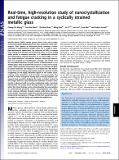Real-time, high-resolution study of nanocrystallization and fatigue cracking in a cyclically strained metallic glass
Author(s)
Wang, Cheng-Cai; Mao, Yun-Wei; Shan, Zhi-Wei; Dao, Ming; Li, Ju; Ma, Evan; Suresh, Subra; Sun, Jun, 1975-; ... Show more Show less
DownloadWang-2013-Real-time, high-reso.pdf (1.324Mb)
PUBLISHER_POLICY
Publisher Policy
Article is made available in accordance with the publisher's policy and may be subject to US copyright law. Please refer to the publisher's site for terms of use.
Terms of use
Metadata
Show full item recordAbstract
Metallic glasses (MGs) exhibit greater elastic limit and stronger resistance to plastic deformation than their crystalline metal counterparts. Their capacity to withstand plastic straining is further enhanced at submicrometer length scales. For a range of microelectromechanical applications, the resistance of MGs to damage and cracking from thermal and mechanical stress or strain cycling under partial or complete constraint is of considerable scientific and technological interest. However, to our knowledge, no real-time, high-resolution transmission electron microscopy observations are available of crystallization, damage, and failure from the controlled imposition of cyclic strains or displacements in any metallic glass. Here we present the results of a unique in situ study, inside a high-resolution transmission electron microscope, of glass-to-crystal formation and fatigue of an Al-based MG. We demonstrate that cyclic straining progressively leads to nanoscale surface roughening in the highly deformed region of the starter notch, causing crack nucleation and formation of nanocrystals. The growth of these nanograins during cyclic straining impedes subsequent crack growth by bridging the crack. In distinct contrast to this fatigue behavior, only distributed nucleation of smaller nanocrystals is observed with no surface roughening under monotonic deformation. We further show through molecular dynamics simulation that these findings can be rationalized by the accumulation of strain-induced nonaffine atomic rearrangements that effectively enhances diffusion through random walk during repeated strain cycling. The present results thus provide unique insights into fundamental mechanisms of fatigue of MGs that would help shape strategies for material design and engineering applications.
Date issued
2013-12Department
Massachusetts Institute of Technology. Department of Materials Science and Engineering; Massachusetts Institute of Technology. Department of Nuclear Science and EngineeringJournal
Proceedings of the National Academy of Sciences
Publisher
National Academy of Sciences (U.S.)
Citation
Wang, C.-C., Y.-W. Mao, Z.-W. Shan, M. Dao, J. Li, J. Sun, E. Ma, and S. Suresh. “Real-Time, High-Resolution Study of Nanocrystallization and Fatigue Cracking in a Cyclically Strained Metallic Glass.” Proceedings of the National Academy of Sciences 110, no. 49 (November 19, 2013): 19725–19730.
Version: Final published version
ISSN
0027-8424
1091-6490